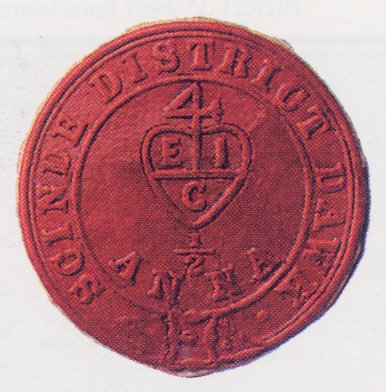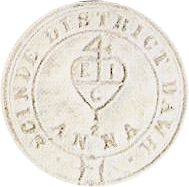
|
Scinde District Dawks - The Premier Stamps of Asia - Page 2 |
The Scinde Dawks were first issued embossed on brittle vermilion wafers which was formerly used to seal letters as is the practice even today i.e., the use of shellac seals, chiefly for insured articles, being obligatory.

Figure 3. Red Scinde Dawk
Cut square copies of the red Scinde dawks do not exist nor the large blocks, strips or pairs, known which gives a clear indication that each stamp must have been punched out from a sealing wafer.
 |
Figure 4. White Scinde Dawk
The red Scinde Dawks were found too brittle for postage use so a new supply, embossed without color on white to bluish wove paper, varying slightly in thickness was introduced. It is not known how many stamps in a sheet were printed but there do exist an irregular block of 14. In this block none of the stamps are in alignment or equidistant both vertically as well as horizontally, hence it must be concluded that the stamps must have been embossed one at a time. Secondly, faint traces of blue lines are often found in white examples to give uniformity in margins between two stamps, thereby, also proving that they must have been embossed singly. In the royal collection there is an example of a white Scinde Dawk showing a complete square of blue dividing lines.
Once again, the new stamps with no color were found unsuitable for postal use as in the dark under candlelight they could not be distinguished especially when they were affixed on white envelopes. So a fresh order was sent to england to emboss them in blue and also to add a ring to the design, engraved on the master die.
|
|
|
Figure 5. Blue Scinde Dawk
Soon after the arrival of the Blue Scinde Dawk they were ordered to be withdrawn and destroyed as by then new stamps were issued from Calcutta for use all over India. Hence, the relative scarcity of the blue specimen. The blue Scinde Dawks come in several shades as shown in Figure 5. and they are also found with the blue dividing lines.